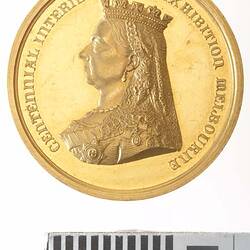Sir George Frederic Verdon, politician and banker, was born in Lancashire, England, on 21 January 1834. He went to Rosall School at the age of 12, and at the age of 17 sailed for Melbourne with a letter of introduction to Dr (later Sir) James Palmer, himself a recent immigrant. Verdon made a brief and fruitless visit to the gold diggings at Mount Alexander, then returned to Melbourne, where his distant family connection with Lieutenant-Governor La Trobe provided an opportunity for a government post. The young Verdon turned down the opportunity, preferring to enter the business world by working for the import/export firm Heape & Grice. Aged only 19, he went to New Zealand to manage their affairs, and when he returned a year later he set up his own sub-agency of the Northern Assurance Co. He also set up business as a ship-chandler in Williamstown. The business collapsed two years later. Verdon also pursued other interests. He commanded the Williamstown Company of the volunteer force, was appointed honorary assistant in the Observatory and was elected to the committee of the Mechanics Institute. At 22 he was elected to Williamstown Municipal Council, and the following year contested the seat of Williamstown. He was considered a radical candidate, particularly in his opposition to Denominational schools, and was defeated. He re-contested the seat two years later, in 1859, and won.
In 1860 Verdon became treasurer, but his slightly protectionist budget was seen as the cause of the government's defeat. In 1861 he married Anne Armstrong, and while out of office studied for the Bar, to which he was admitted in 1863. He never practised - in the year he was admitted he again became treasurer, and succeeded in passing his protectionist budget in a changed political climate. He also managed to find money for a new building and instruments for the Observatory, assisted Professor McCoy in establishing a national museum and provided support to Ferdinand Mueller for his botanical research. He also became a member of the royal commission on fine arts. His concerns about national security saw him obtain the HMS Nelson as a training ship from Britain, as well as 100,000 pounds towards the purchase price of the armour-plated Cerberus. His position as treasurer ended in March 1868, when he became Victoria's first Agent-general and sailed for London. Here he revelled in his social prestige, and became a member of the Royal Society and the Athenaeum Club. In 1872 he became Australian Manager of the English, Scottish and Australian Chartered Bank, and in 1889 chariman of the Associated Banks. He linked interests rates to those of the Bank of New South Wales, and took advantage of his links with government in financial negotiations. He was not above criticism, however, and allowed liquidity standards and coin and bullion ratios to fall, which contributed to the Bank's collapse in 1893. He retired in 1891, aged 57.
Verdon enjoyed the fruits of his office, including a mansion at Mount Macedon. He maintained his support of the arts and became trustee, vice-president and then president of the Public Library, Museums and National Gallery in 1883-96. He was described as 'pompous and over-bearing', and probably felt it quite fitting when a gallery was named after him in 1886. He was also president of the Philharmonic Society and the Victorian Institute of Architects. He was a royal commissioner for the Centennial International Exhibition of 1888-89, and was awarded a medal for this work (NU 16450). His wife died in the year that the exhibition ended. Verdon died of diabetes at the Melbourne Club on 13 September 1896. He was survived by three of his four sons.
References:
Australian Dictionary of Biography website http://adbonline.anu.edu.au/adbonline.htm
More Information
-
Keywords
-
Localities
-
Authors
-
Article types

